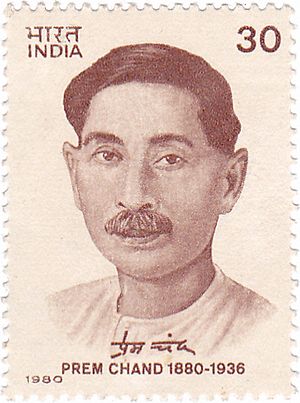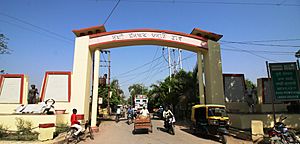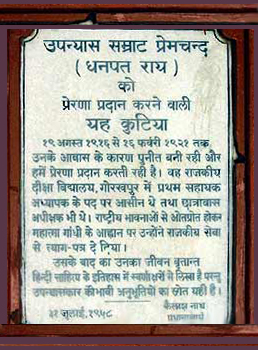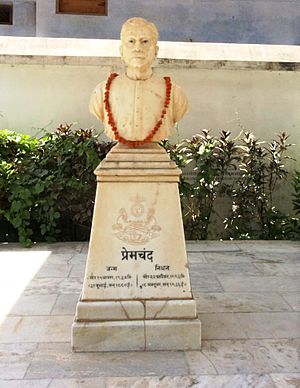Premchand facts for kids
Quick facts for kids
Premchand
|
|
|---|---|
 |
|
| Born | Dhanpat Rai Srivastava 31 July 1880 Lamhi, Banaras State, British India |
| Died | 8 October 1936 (aged 56) Banaras, Banaras State, British India |
| Pen name | Premchand, Nawab Rai |
| Occupation | Novelist, short story writer |
| Language | Hindi, Urdu |
| Nationality | Indian |
| Years active | 1920–1936 |
| Notable works | Godaan, Bazaar-e-Husn, Karmabhoomi, "Shatranj ke Khiladi", Gaban, Mansarovar, Idgah |
| Spouse | First wife (m. 1895; estranged)
Shivarani Devi
(m. 1906; died 1936) |
| Children | Amrit Rai |
| Signature | |
Dhanpat Rai Srivastava (born July 31, 1880 – died October 8, 1936), known by his pen name Premchand, was a famous Indian writer. He wrote in the Hindustani language, which includes both Hindi and Urdu.
Premchand was a pioneer in writing social stories in Hindi and Urdu. He was one of the first authors to write about unfair social classes and the difficulties faced by women and workers in the late 1800s. He is considered one of the most important Hindi writers of the early 20th century. Some of his well-known works include Godaan, Karmabhoomi, Gaban, Mansarovar, and Idgah. He published his first collection of five short stories in 1907, called Soz-e-Watan.
He first used the pen name "Nawab Rai" but later changed it to "Premchand." Hindi writers called him "Upanyas Samrat," which means "Emperor Among Novelists." He wrote more than a dozen novels, about 300 short stories, many essays, and translated several foreign books into Hindi.
Premchand's Life Story
Early Years and Education
Premchand was born Dhanpat Rai on July 31, 1880, in Lamhi, a village near Banaras. His family owned some land. His grandfather was a village record-keeper, and his father was a post office clerk. His mother died when he was eight years old, and his grandmother, who raised him, also died soon after. Premchand felt alone because his older sister was already married, and his father was always busy. His father remarried, but Premchand did not feel much love from his stepmother. The idea of a stepmother often appeared in his later stories.
As a child, Dhanpat Rai loved to read. He found comfort in books and fantasy stories. He even took a job selling books, which allowed him to read many different kinds of books. He learned English at a missionary school. He wrote his first story in Gorakhpur, but it was never published and is now lost.
In 1895, when he was 15 and still in school, he had an arranged marriage. His father died in 1897. He passed his high school exam but could not get a scholarship for college. He then worked as a tutor and later as an assistant teacher to support himself and his family.
Starting His Writing Career
In 1900, Premchand got a job as an assistant teacher in Bahraich. He was later transferred to Pratapgarh.
Dhanpat Rai first wrote under the name "Nawab Rai." His first short novel, Asrar-e-Ma'abid (Secrets of God's Abode), was published in a weekly Urdu newspaper from 1903 to 1905. This novel looked at corruption among temple priests.
Time in Kanpur
From Pratapgarh, Dhanpat Rai moved to Kanpur in 1905 and stayed there for about four years. In Kanpur, he met Munshi Daya Narain Nigam, the editor of the Urdu magazine Zamana. Premchand later published many articles and stories in this magazine.
In 1906, Premchand married Shivarani Devi, a child widow. This was a very brave step at that time, and he faced a lot of social disapproval. After his death, Shivarani Devi wrote a book about him called Premchand Ghar Mein (Premchand in House).
In 1905, Premchand wrote an article about the Indian leader Gopal Krishna Gokhale. He also published his first story, "Duniya ka Sabse Anmol Ratan" ("The Most Precious Jewel in the World"), in Zamana in 1907. This story suggested that the most precious thing was the last drop of blood shed for independence. Many of his early stories were patriotic and inspired by the Indian independence movement.
His second short novel, Hamkhurma-o-Hamsavab (Prema in Hindi), was published in 1907. It explored the issue of widow remarriage in society. Another short novel, Kishna, was published in 1907, which made fun of women's love for jewelry.
In 1907, Premchand's first collection of short stories, Soz-e-Watan, was published. This collection included four stories that aimed to inspire Indians to fight for freedom.
Becoming Premchand
In 1909, Premchand was transferred to Hamirpur. Around this time, the British government noticed Soz-e-Watan and banned it, calling it a dangerous work. The British officer in Hamirpur ordered a search of Premchand's house, and about 500 copies of Soz-e-Watan were burned. After this, Munshi Daya Narain Nigam, the editor of Zamana, advised him to use the pen name "Premchand." Dhanpat Rai stopped using "Nawab Rai" and became known as Premchand.
In 1914, Munshi Premchand started writing in Hindi. He was already known as an Urdu writer. His first Hindi story, "Saut" ("Co-Wife"), was published in the magazine Saraswati in December 1915. His first Hindi short story collection, Sapta Saroj, came out in June 1917.
Life in Gorakhpur
In August 1916, Premchand was promoted and moved to Gorakhpur. He became an Assistant Master at the Normal High School.
He loved reading classics from other languages and translated many of them into Hindi.
In 1919, Premchand's first major novel, Seva Sadan, was published in Hindi. It was originally written in Urdu as Bazaar-e-Husn. This novel was very popular and helped Premchand become widely recognized.
By 1921, he had been promoted to Deputy Inspector of Schools. On February 8, 1921, he attended a meeting where Mahatma Gandhi asked people to resign from government jobs as part of the non-cooperation movement. After thinking for five days, Premchand decided to resign from his job, even though he had two children and a pregnant wife to support.
Return to Banaras
After leaving his job, Premchand moved back to Banaras on March 18, 1921. He decided to focus completely on his writing. Until his death in 1936, he often faced financial problems and health issues.
In 1923, he started his own printing press and publishing house in Banaras, called "Saraswati Press." In 1924, his novel Rangbhoomi was published. It features a blind beggar named Surdas as its main character.
In Nirmala (1925) and Pratigya (1927), Premchand's writing became more balanced and realistic. Nirmala was a novel about the dowry system, where a bride's family gives money or gifts to the groom's family. Pratigya ("The Vow") dealt with the topic of widow remarriage.
In 1928, Premchand's novel Gaban ("Embezzlement") was published. It focused on the greed of the middle class. In March 1930, Premchand started a literary and political weekly magazine called Hans. It aimed to inspire Indians to protest against British rule. The magazine often had strong political views but did not make money. Premchand also edited another magazine, Jagaran, which also lost money.
In 1931, Premchand moved to Kanpur to teach at Marwari College but left due to disagreements. He then returned to Banaras and became the editor of Maryada magazine. In 1932, he published another novel, Karmabhoomi. He also briefly worked as a headmaster and later as an editor in Lucknow.
Time in Bombay
Premchand went to Bombay on May 31, 1934, to work in the Hindi film industry. He hoped that the high salary would help him with his financial problems. He wrote the script for the film Mazdoor ("The Labourer"), which showed the difficult lives of workers. Premchand even had a small role in the film as a labor leader. The film was banned in some places because it encouraged workers to stand up against factory owners.
By 1934–35, Premchand's Saraswati Press was in debt, and he had to stop publishing Jagaran. Premchand did not like the commercial side of the Bombay film industry and wanted to return to Banaras. He left Bombay on April 4, 1935, before his one-year contract was over.
Final Years
After leaving Bombay, Premchand wanted to live in Allahabad, where his sons were studying. However, due to his financial and health issues, he had to give his magazine Hans to another organization and move back to Banaras.
In 1936, Premchand was chosen as the first President of the Progressive Writers' Association in Lucknow. He died on October 8, 1936, after being sick for several days.
Godaan (The Gift of a Cow, 1936), Premchand's last completed novel, is often considered his best work. It tells the story of Hori, a poor farmer who desperately wants a cow, which was a symbol of wealth in rural India.
In 1936, Premchand also published "Kafan" ("Shroud"). In this story, a poor man collects money for his dead wife's funeral but spends it on food and drink instead. Premchand's last story, "Cricket Match," was published in Zamana in 1938, after he had passed away.
Premchand's Writing Style
Premchand is known as the first Hindi author whose writings showed realism. His novels described the problems faced by poor people and the middle class in cities. He used his writing to raise awareness about national and social issues. He often wrote about topics like corruption, child widowhood, the feudal system, poverty, and the Indian independence movement.
Premchand became interested in politics in the late 1900s, and this showed in his early works, which had patriotic themes. He supported greater political freedom for India. He often hid his opposition to the British government in his stories by setting them in older times or other countries, because of strict censorship.
In the 1920s, he was influenced by Mahatma Gandhi's non-cooperation movement and efforts for social change. During this time, his works dealt with social issues such as poverty, exploitation by landlords (Premashram, 1922), the dowry system (Nirmala, 1925), and political oppression (Karmabhoomi, 1931). Premchand wanted to improve the lives of farmers and workers. He was against fast industrial growth, believing it would harm farmers and lead to worker oppression. This can be seen in works like Rangbhoomi (1924).
Premchand's impact on Indian literature is huge. He created the serious short story and novel in both Hindi and Urdu. He changed fiction in these languages from simple romantic tales to realistic stories, similar to European fiction of his time. He remains a master in both languages.
In his last days, he focused on village life as a setting for complex stories, like in Godaan (1936) and the short-story collection Kafan (1936).
Premchand's Legacy
India Post honored Premchand with a special postage stamp on July 31, 1980.
His childhood home in Lamhi is being restored by the government. An institute has also been set up in Lamhi to study his works. A college in Siliguri, the Munshi Premchand Mahavidyalaya, is named after him.
On July 31, 2016, Google created a Google Doodle to celebrate Premchand's 136th birthday.
List of Premchand's Works
Premchand wrote over 300 short stories and 14 novels, along with many essays, letters, plays, and translations. Many of his works were translated into English and Russian after his death.
Novels by Premchand
| Hindi Title | Urdu Title | Year | What it's About |
|---|---|---|---|
| Devasthan Rahasya | Asrar-e-Ma'abid | 1903–1905 | The Mystery of God's Abode; explores corruption among temple priests. |
| Prema | Hamkhurma-o-Hamsavab | 1907 | A story about a man who marries a young widow despite social disapproval. |
| Kishna | 1907 | A lost work that made fun of women's love for jewelry. | |
| Roothi Rani | 1907 | ||
| Soz-e-Watan | 1907, 1909 | A collection of patriotic stories banned by the British government. | |
| Vardaan | Jalwa-e-Isar | 1912 | Boon; about childhood friends and their life paths. |
| Seva Sadan | Bazaar-e-Husn | 1919 (Hindi), 1924 (Urdu) | A well-received novel that brought Premchand wider fame. |
| Premashram | Gosha-e-Afiyat | 1922 | |
| Rangbhoomi | Chaugan-e-Hasti | 1924 | Playground; features a blind beggar as the hero. |
| Nirmala | Nirmala | 1925 | The Second Wife; deals with the dowry system in India. |
| Kaayakalp | Parda-i-Majaz | 1926 (Hindi), 1934 (Urdu) | |
| Pratigya | Bewa | 1927 | Deals with widow remarriage. |
| Gaban | Ghaban | 1931 | Focuses on the greed of the middle class. |
| Karmabhoomi | Maidan-e-Amal | 1932 | |
| Godaan | 1936 | The Gift of a Cow; about the struggles of a poor farmer. | |
| Mangalsootra (incomplete) | 1936 | Premchand only finished a small part of this novel. |
Short Stories by Premchand
Many of Premchand's stories are in the 8-volume collection Mansarovar (1900–1936). Here are some of his stories:
| Title | Year | What it's About |
|---|---|---|
| "Jihad" (Hindi) | A story about how extreme education can harm society's peace. | |
| "Lekhak" (Hindi) "Adeeb ki Izat" (Urdu) |
A writer seeks respect for his work but learns he must sacrifice for others. | |
| "Duniya ka Sabse Anmol Ratan" | 1907 | The Most Precious Jewel in the World; it's the blood shed for a nation's freedom. |
| "Bade Bhai Sahab" | 1910 | A story of two brothers, their disagreements, and how they understand each other. |
| "Beti ka Dhan" | 1915 | A daughter sells her jewelry to help her father pay his debts. |
| "Saut" | 1915 | Co-Wife. |
| "Panch Parameshvar" | 1916 | A friendship is tested when one friend judges against the other, but they reunite. |
| "Ishwariya Nyaya" | 1917 | The Divine Law. |
| "Durga ka Mandir" | 1917 | The Temple of Durga. |
| "Maa" | 1921 | Mother. |
| "Gulli Danda" | 1925 | About a popular rural sport, showing how social differences affect a game between old friends. |
| "Balidan" | 1918 | Sacrifice. |
| "Putra Prem" | 1920 | Love of a Son. |
| "Boodhi Kaki" | 1921 | The Old Aunt; an old woman longs for love from her family. |
| "Pariksha" | 1923 | The Test; set during Nadir Shah's invasion of Delhi. |
| "Shatranj ke Khiladi" (Hindi) "Shatranj ki Bazi" (Urdu) |
1924 | Two noblemen are so obsessed with chess that they ignore their duties and a major crisis. |
| "Idgah" | 1933 | A poor boy buys tongs for his grandmother on Eid, instead of toys for himself. |
| "Nashaa" | 1934 | Two friends from different social classes explore their friendship and aspirations. |
| "Kafan" | 1936 | A poor father and son spend money meant for a funeral on food and drink. |
| "Cricket Match" | 1937 | Published after his death. |
| "Namak ka Daroga" | 1925 | The Salt Inspector; an idealist police officer faces challenges. |
| "Poos ki Raat" | 1930 | A Winter Night; a poor farmer tries to protect his field on a very cold night. |
| "Lottery" | A family fights over what they would do if they won a lottery, but no one from their area wins. |
Other stories include:
- "Abhushan"
- "Agni Samadhi"
- "Alagyojha"
- "Amrit"
- "Atmaram"
- "Bade Ghar ki Beti" (1926)
- "Bhoot" (1926)
- "Chori"
- "Daroga Sahab"
- "Devi"
- "Dhaai ser Gehun"
- "Dikri ke Rupaye"
- "Do Bahanein"
- "Do Sakhiyan" (1926)
- "Do Bailon ki Katha"
- "Do Kabren" (1920)
- "Doodh ka Damm" (1910)
- "Gilli danda"
- "Grihaneeti"
- "Gurumantra" (1927)
- "Har ki Jeet" (1925)
- "Jail" (1931)
- "Jihad"
- "Juloos" (1930)
- "Jurmana"
- "Khudai Fauzdaar"
- "Mahatirtha"
- "Manushya ka Param Dharma" (March 1920)
- "Maryada ki Vedi"
- "Mukti Marg" (1922)
- "Muktidhan" (1921)
- "Mamta" (1928)
- "Mandir" (1927)
- "Nairashya"
- "Nimantran" (1926)
- "Pashu se Manushya"
- "Prayaschit"
- "Prem Purnima"
- "Prem ka Uday" (1923)
- "Prerna" (1925)
- "Ramleela" (1926)
- "Samar Yatra" (1930)
- "Sati" (1925)
- "Satyagraha" (1923)
- "Sawa ser Gehun" (1921)
- "Sewa Marg"
- "Subhagi"
- "Suhag ki Sari" (1923)
- "Sujan Bhagat"
- "Rani Sarndha" (1930)
- "Swatva Raksha"
- "Thakur ka Kuaan" (1924)
- "Thriya Charita"
- "Tagada" (1924)
- "Khoon Safed" (1923)
- "Udhar ki Ghadi"
- "Vajrpaat" (1922)
- "Raja Hardaul" (1925)
- "Vimata"
- "Hajje Akbar"
- "Sautele Maa"
- "Kajaki" (1921)
- "Ibrat"
- "Roshni"
- "Bhadde ka Tattu" (1922)
- "Nijat"
- "Mazdoor"
- "Kazaaki" (1921)
- "Mritak Bhoj" (1922)
Translations by Premchand
Premchand translated many books from other languages into Hindi, including works by Leo Tolstoy and Oscar Wilde.
| Premchand's Title | Original Work |
|---|---|
| Ahankar | Thaïs by Anatole France (an adaptation) |
| Azad Katha | Fasana-e-Azad (1880) by Ratan Nath Dhar Sarshar |
| Chandi ki Dibiya | The Silver Box (1906) by John Galsworthy |
| Hartal | Strife (1909) by John Galsworthy |
| Nyaya | Justice (1910) by John Galsworthy |
| Tolstoy ki Kahaniyan | Stories by Leo Tolstoy |
Other Works
- Film script: Mill (Mazdoor) (1934) - This was the only film script Premchand wrote, and he also had a small role in it.
- Plays: Karbala, Tajurba, Prem ki Vedi, Roohani Shadi, Sangram
- Essays: Kuchh Vichar (two parts), Qalam Tyag aur Talwar
- Biographies: Durgadas, Mahatma Sheikhsadi (about the poet Saadi)
- Children's books: Bal Kahaniyan Sumpurn, Manmodak, Ram Charcha
Films and TV Shows Based on Premchand's Works
Many of Premchand's stories and novels have been made into films and TV shows:
- Sevasadanam (1938) was a film starring M. S. Subbulakshmi.
- A film version of his novel Gaban was released in 1966.
- Heera Moti (1959) was based on his story "Do Bailon ki Katha."
- In 1977, Satyajit Ray made a film based on Premchand's short story "Shatranj ke Khiladi" ("The Chess Players"). It won an award for Best Feature Film in Hindi.
- Oka Oori Katha (A Story of a Village), a 1977 Telugu film, was based on his story "Kafan."
- Saanch Ko Aanch Nahin (1979) was based on "Panch Parmeshwar."
- Bazaar E Husn (2014) was a Hindi film based on his novel of the same name.
- Ek Betuke Aadmi Ki Afrah Raatein (2019) was partly based on his story "Bhoot."
Several TV series based on Premchand's works have been shown on the Indian public broadcaster Doordarshan. These include Munshi Premchand's Guldasta, Munshi Premchand ki Kahani, and Tehreer Munshi Premchand Ki. TV films like Sadgati and Seva Sadan were also aired.
See Also
 In Spanish: Premchand para niños
In Spanish: Premchand para niños




